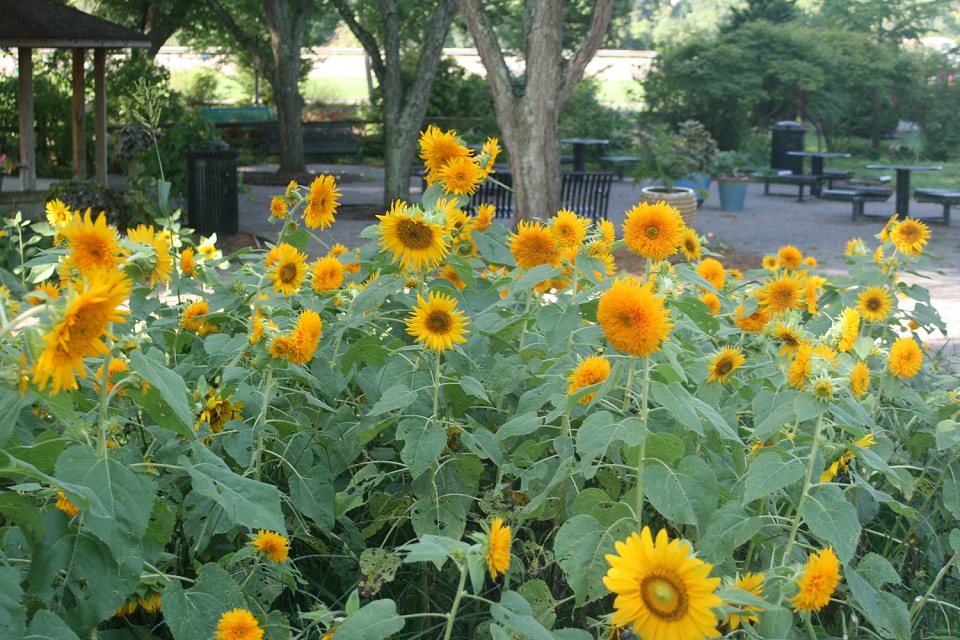
Submitted by James Newburn, assistant director, UT Gardens, Knoxville
Sunflower – the very name brings a smile to most people’s faces. Sunflowers are one of the few flowers, along with perhaps tulips and roses, that even the most inexperienced gardener or city-slicker can recognize. Who can but help enjoy these big, bold, and beautiful paragons of summer? And as the summer wanes, many varieties are still putting on a show.
Although the large, yellow varieties like ‘Mammoth’ are perhaps the most familiar, sunflowers actually come in a variety of colors, sizes and forms that can be appropriate for any garden. ‘Chianti’ has a wine-red flower, ‘Velvet Queen’ has a blending of orange, yellow and red all on the same bloom and ‘Shock-o-Lat’ has a rich red-brown center with a gold outer margin.
Sunflowers vary in size from dwarf, about three feet tall, to giant which can get up to nine feet tall. Many of the dwarf varieties like ‘Elegance’ exhibit heavy branching, resulting in many blooms on one plant. These are ideal for cutting for indoor enjoyment. Double-flowering and pom-pom cultivars are also available, adding to the range of choices. ‘Teddy Bear’ is a favorite, with a pin cushion type flower head in a yellow-orange color.
Sunflowers (Helianthus annuus), as the scientific name implies, are annual plants that are best grown from seed. Rarely would you find sunflowers in pots or flats for the garden as they do not transplant well.
Once the soil has warmed, sow directly into well-drained soil in a sunny location. Sunflowers generally take about 45-60 days to flower and can bloom up to 5 weeks. To extend bloom time, especially with single-blooming varieties, succession sowing is a great option. This is done by staggering sowing times by about two weeks. Sow your first crop, wait two weeks, then sow another, wait two more weeks and if desired sow a third. Be sure to space the plants out at a suitable distance from each other so that the younger seedling are not shaded by the more mature plants.
Sunflowers are great for attracting pollinators to your garden. Bees and butterflies love the extraordinary amount of pollen produced. Be aware that some cultivars, especially those bred for cut flowers, don’t produce pollen. These are generally labeled.
Critters of all kinds including birds, squirrels, and even humans love sunflower seeds. Rich in essential fatty acids, vitamins, and minerals, they are an ideal attractant of wildlife. Goldfinches especially are drawn to this abundant food source and give a sunflower patch an added dimension of movement and color. When they are feeding it is a wonderful sight to behold. For human consumption the tastiest seed tends to be large black and white striped seed. Good selections for “confectionary” or edible seed are ‘Russian Mammoth, ‘Paul Bunyun’ and ‘Miriam’.Whether you plant a few or a field, nothing beats the beauty of sunflowers. They will definitely put a smile on your face.
James Newburn is the assistant director of the UT Gardens in Knoxville. The Gardens include plant collections located in Knoxville, Jackson and Crossville. Designated as the official botanical garden for the State of Tennessee, the collections are part of the UT Institute of Agriculture. The gardens’ mission is to foster appreciation, education and stewardship of plants through garden displays, educational programs and research trials. The gardens are open during all seasons and free to the public. For more information see utgardens.tennessee.edu.
Contact:
James Newburn, assistant director, UT Gardens, Knoxville, 865-974-7256